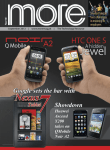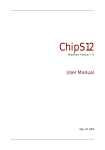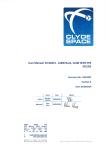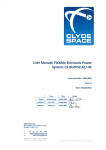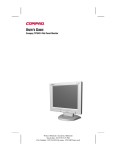Download System Test Plan - The University of Texas at Arlington
Transcript
Department of Computer Science and Engineering the University of Texas at Arlington System Test Plan BehindtheCurtain Enterprises Project AVALANCHE Team Members: Kyle Burgess Kyle Crumpton Austen Herbst Bilal Nawaz Jason Sprowl Last Updated: 3/24/2013 7:00 pm System Test Plan – v1.0 AVALANCHE Table of Contents Document Revision History ........................................................................................................................5 List of Figures..............................................................................................................................................6 List of Tables ...............................................................................................................................................7 1. Introduction..........................................................................................................................................8 1.1 Document Overview .....................................................................................................................8 2. 1.2 Purpose..........................................................................................................................................8 1.3 Scope.............................................................................................................................................8 1.4 Acronyms ......................................................................................................................................8 References..........................................................................................................................................10 2.1 Overview..........................................................................................................................................10 2.2 System Requirement Specification..................................................................................................10 2.3 Architecture Design Specification ...................................................................................................11 2.4 Detailed Design Specification .........................................................................................................17 3. 4. Test Items...........................................................................................................................................21 3.1 Overview.....................................................................................................................................21 3.2 Relational Diagram .....................................................................................................................22 3.3 Hardware Tests ...........................................................................................................................23 3.4 Unit Tests ....................................................................................................................................23 3.5 Component Tests.........................................................................................................................28 3.6 Integration Tests..........................................................................................................................31 3.7 System Verification Tests ...........................................................................................................32 Risks ..................................................................................................................................................33 4.1 Overview.....................................................................................................................................33 4.2 5. Risk Table ...................................................................................................................................33 Testable Features ...............................................................................................................................36 5.1 Overview.....................................................................................................................................36 5.2 Customer Requirements..............................................................................................................36 March 24, 2013 2 BehindtheCurtain Enterprises System Test Plan – v1.0 AVALANCHE 5.3 Packaging Requirements.............................................................................................................39 5.4 Performance Requirements .........................................................................................................40 5.5 Safety Requirements ...................................................................................................................41 5.6 Maintenance and Support Requirements ....................................................................................41 5.7 Other Requirements ....................................................................................................................42 6. Non Tested Requirements.....................................................................................................................44 6.1 Overview.....................................................................................................................................44 7. 8. 9. 6.2 Customer Requirements..............................................................................................................44 6.3 Packaging Requirements.............................................................................................................44 6.4 Performance Requirements .........................................................................................................44 6.5 Safety Requirements ...................................................................................................................44 6.6 Maintenance and Support Requirements ....................................................................................45 6.7 Other Requirements ....................................................................................................................45 Overall Test Strategy .........................................................................................................................46 7.1 Overview.....................................................................................................................................46 7.2 Overall Test Strategy ..................................................................................................................46 7.3 Methodology ...............................................................................................................................46 7.4 Testing Metrics ...........................................................................................................................47 7.5 Testing Requirements .................................................................................................................47 Acceptance Criteria ...........................................................................................................................48 8.1 Overview.....................................................................................................................................48 8.2 Hardware Tests ...........................................................................................................................48 8.3 Unit Tests ....................................................................................................................................48 8.4 Component Tests.........................................................................................................................48 8.5 Integration Tests..........................................................................................................................49 8.6 System Verification Tests ...........................................................................................................49 Test Deliverables ...............................................................................................................................50 March 24, 2013 3 BehindtheCurtain Enterprises System Test Plan – v1.0 AVALANCHE 9.1 Overview.....................................................................................................................................50 9.2 Deliverables ................................................................................................................................50 10. Test Schedule..................................................................................................................................52 10.1 Overview .................................................................................................................................52 10.2 11. Schedule ..................................................................................................................................52 Approvals........................................................................................................................................53 March 24, 2013 4 BehindtheCurtain Enterprises System Test Plan – v1.0 AVALANCHE Document Revision History Revision Revision Number Date 0.1 1.0 3/20 3/24 March 24, 2013 Description Rationale Initial Draft STP Review Draft Revised according to peer review. 5 BehindtheCurtain Enterprises System Test Plan – v1.0 AVALANCHE List of Figures Figure # 2-1 2-2 2-3 3-1 March 24, 2013 Title Page # Architecture Overview Subsystem Overview Module Decomposition Relational Diagram 12 14 18 22 6 BehindtheCurtain Enterprises System Test Plan – v1.0 AVALANCHE List of Tables Table # Title 2-1 2-2 2-3 3-1 3-2 3-3 3-4 3-5 3-6 3-7 3-8 3-9 3-10 3-11 3-12 3-13 3-14 3-15 4-1 10-1 11-1 Data Elements Requirements Mapping Requirements Traceability Matrix Hardware Tests GUI Layer Unit Tests Data Processing Layer Unit Tests Data Acquisition Layer Unit Tests Local Storage Layer Unit Tests Network Layer Unit Tests Cloud Storage Layer Unit Tests GUI Layer Component Tests Data Processing Layer Component Tests Data Acquisition Layer Component Tests Local Storage Layer Component Tests Network Layer Component Tests Cloud Storage Layer Component Tests Integration Tests System Verification Tests Risks Test Schedule Approvals March 24, 2013 Page # 7 15 17 20 23 24 27 27 27 28 28 29 29 30 30 30 31 32 32 35 52 53 BehindtheCurtain Enterprises System Test Plan – v1.0 AVALANCHE 1. 1.1 Introduction Document Overview This document covers the System Test Plan for Team BehindtheCurtain’s Project AVALANCHE. Included in this document will be the various test plans for Project AVALANCHE. The details of this System Test Plan have been thoroughly explored and discussed and will be including Unit Testing, Component Testing, Integration Testing, and System Validation Testing. The tests covered in this System Test Plan cover requirements specified in the SRS, ADS and DDS. 1.2 Purpose This purpose of this document is to detail plans for system verification as they relate to each component and integration as a whole. The project will be verified on both a high level (system architecture) and on a low level which will cover our DDS. Each requirement will be verified and given a testing priority which reflects the total impact the test has on the system ranging from high to low. The primary purpose of the STP will be to verify that each requirement specified in the SRS is met on an acceptable level. 1.3 Scope Project AVALANCHE exists as a modification to a racing gauge provided by Team BehindtheCurtain’s sponsor. The project is designed to take an existing racing gauge using an LCD screen and move it to a mobile application framework for ease of use and advanced user features. Server software will also be provided as Project AVALANCHE includes a cloud storage feature. The scope of the STP detailed in this document is to verify each requirement detailed in the SRS and assure proper system functionality as specified in the DDS. This document will include details on how Project AVALANCHE will be Unit Tested, Component Tested, Integration Tested and Validated. 1.4 Acronyms BLE- Bluetooth Low Energy 4.0 CAN Bus- Controller Area Network Bus March 24, 2013 8 BehindtheCurtain Enterprises System Test Plan – v1.0 AVALANCHE iOS- iPhone Operating System MCU- Microcontroller Unit (MC9S12C128) RSM- Redline Gauge Remote Sensor Module SCI- Serial Communications Interface TX- Transfer RX- Receive RTS- Request to Send CTS- Clear to Send UART- Universal Asynchronous Receiver/Transmitter STP- System Test Plan DDS- Detailed Design Specification ADS- Architectural Design Specification SRS- System Requirements Specification March 24, 2013 9 BehindtheCurtain Enterprises System Test Plan – v1.0 AVALANCHE 2. References 2.1 Overview This section describes the requirements, laid out in the SRS, and design aspects, laid out in the ADS and DDS, that will be considered when designing tests cases for each phase of testing. 2.2 System Requirement Specification The system requirement specification outlines the system requirements of the AVALANCHE system. 2.2.1 Customer Requirements 2.2.1.1 Read Data from CAN BUS 2.2.1.2 Profile Each Run 2.2.1.3 Bluetooth Capability 2.2.1.4 Mobile iPhone App 2.2.1.5 Mobile Android App 2.2.1.6 Microcontroller Data Acquisition 2.2.1.7 Microcontroller Packaged Output 2.2.1.8 Interface to CAN BUS 2.2.1.9 Configuration Support Page 2.2.1.10 Multi-Gauge Graphical User Interface 2.2.1.11 App Consistency 2.2.1.12 Hardware Identification 2.2.2 Packaging Requirements 2.2.2.1 User Manual 2.2.2.2 Secured Enclosure March 24, 2013 10 BehindtheCurtain Enterprises System Test Plan – v1.0 2.2.2.3 Printed Circuit Board 2.2.2.4 Server Software 2.2.2.5 App Store Submissions AVALANCHE 2.2.3 Performance Requirements 2.2.3.1 Real-Time Output 2.2.3.2 Reliable Data Transfer 2.2.3.3 Mobile Cross-Compatibility 2.2.3.4 Multi-threading 2.2.4 Safety Requirements 2.2.4.1 Secured Fastening 2.2.4.2 Electric Safety 2.2.5 Maintenance and Support Requirements 2.2.5.1 Support Future Mobile Operating System 2.2.5.2 Code Documentation 2.2.5.3 Testing 2.2.5.4 Maintenance Cutoff Date 2.2.6 Other Requirements 2.2.6.1 Statistics Database 2.2.6.2 User Accounts 2.2.6.3 Encryption of Web Traffic 2.2.6.4 Salt and Hash Passwords 2.2.6.5 Accurate Gauge Display 2.3 Architecture Design Specification The architecture design specification outlines the planned architecture of the AVALANCHE system. 2.3.1 Layer Overview March 24, 2013 11 BehindtheCurtain Enterprises System Test Plan – v1.0 AVALANCHE Figure 2-1 Architecture Overview 2.3.1.1 GUI Layer The GUI Layer acts as the intermediary between users and Project AVALANCHE. It displays the data from the physical gauge in a graphical form, providing both sensor readouts and charts and metrics for past runs, as well as parsing user input into the system. 2.3.1.2 Data Processing Layer The Data Processing Layer processes raw data received from the physical gauge via the Bluetooth Layer and uses user inputted configuration data to format the device input into an user readable form which is outputted to the user through the GUI Layer. It will also send this data to be saved in the Local Storage Layer, either locally or on the server via the Network Layer. These saved runs will be able to analyzed by the Data Processing Layer to create charts, graphs, and metrics for run analysis by the user. 2.3.1.3 Bluetooth Layer March 24, 2013 12 BehindtheCurtain Enterprises System Test Plan – v1.0 AVALANCHE The Bluetooth Layer will handle the Bluetooth pairing between the hardware module and the mobile device and will be responsible for transferring gauge sensor data from the Data Acquisition Layer to the Data Processing Layer over Bluetooth. 2.3.1.4 Data Acquisition Layer The Data Acquisition Layer encompasses the hardware module and will be responsible for pulling gauge data off the CAN Bus and packaging that data for transfer over the Bluetooth Layer. 2.3.1.5 Local Storage Layer The Local Storage Layer will be responsible for storing saved runs for later analysis. The Local Storage Layer will encompass local device storage on the mobile phone. The Local Storage Layer will be accessed by the Data Processing Layer directly through the mobile device file system. 2.3.1.6 Network Layer The Network Layer is responsible for secure and reliable data transfer between the Data Processing and Cloud Storage Layer. It will use AES and RSA encryption to make sure that all communication between the layers is secure and private and TCP to ensure that the data is transferred successfully between the layers. 2.3.1.7 Cloud Storage Layer The Cloud Layer will be responsible for storing saved runs for later analysis. The Cloud layer will encompass the database storage on the server. The Cloud Storage Layer will be accessed by the Storage Layer directly through the Network Layer. The Cloud Storage Layer will also store user account information on the database for access by any mobile device with the required applications. 2.3.2 Subsystem Overview Each layer in the AVALANCHE System is broken down into smaller subsystems as defined by Figure 2-2. March 24, 2013 13 BehindtheCurtain Enterprises System Test Plan – v1.0 AVALANCHE Figure 2-2 Subsystem Overview 2.3.3 Subsystem Overview The data flows illustrated by Figure 2-2 are defined in Table 2-1. Data Flow Description A1 Real time unformatted byte stream data being pulled from the CAN Bus on the existing gauge describing the status of each gauge sensor. A2 Real time unformatted sensor data that was pulled from the CAN Bus. A3 Gauge sensor data that has been packaged and formatted for Bluetooth transmission. B1 Gauge sensor data that has been transmitted through the Bluetooth Layer. B2 Bluetooth protocol data for Bluetooth sync between the Data Processing and Bluetooth Layers. B3 Sync State is delivered to MCU. March 24, 2013 14 BehindtheCurtain Enterprises System Test Plan – v1.0 AVALANCHE P1 Processed real time sensor data to be saved. P2 Processed real time sensor data to be outputted in the GUI Layer. P3 Post processed run data that has been put analyzed for graphs and metrics. P4 Run data that is being stored locally in the Storage Layer. P5 Gauge Sensor data that has been transmitted to Data Processing Layer P6 Saved run data information G1 User input detailing configurations, preferences, and desired output formats. G2 Description of user desired output format. G3 User configuration settings. G4 Vehicle specific configuration settings needed to process raw sensor data. G5 Details the requested run to be analyzed. G6 GUI output to the user. The GUI will only be able to display up to 12 sensors at one time. G7 Current Configuration to Display L1 Saved run data to be analyzed from local storage. L2 Saved run data that is being transferred to the Network. C1 Saved run data that has been requested by Post Processing Subsystem being transferred via the Network Layer. Being sent from the cloud to the mobile device. N1 Run data to be sent over the internet using TCP. Will be encrypted if data contains usernames or passwords. N2 Run data being sent over the internet. N3 Decrypted run data to be post processed. Transferred from the cloud to the mobile device. N4 Run data to be saved in server database. Transferred from the mobile device to the cloud. Table 2-1 Data Elements March 24, 2013 15 BehindtheCurtain Enterprises System Test Plan – v1.0 AVALANCHE 2.3.4 Requirements Mapping Req # Requirement Data Acquisition Layer Bluetooth Layer Data Processing GUI Layer 4.1 Read Data from CAN BUS 4.2 Profile Each Run 4.3 Bluetooth Capability 4.4 Mobile iPhone App X X 4.5 Mobile Android App X X 4.6 Microcontroller Data Acquisition X 4.7 Microcontroller Packaged Output X 4.8 Interface to CAN X BUS 4.9 Configuration Support Page X X Reliable Data Transfer 6.3 Mobile CrossCompatibility March 24, 2013 X X 4.11 App Consistency 6.2 X Network Layer X X Real-Time Output Cloud Storage Layer X 4.10 Multi-Gauge Graphical User Interface 6.1 Local Storage Layer X X X X 16 X BehindtheCurtain Enterprises System Test Plan – v1.0 AVALANCHE 6.4 Multi-threading X 9.1 Statistics Database X 9.2 User Accounts X 9.3 Encryption of Web Traffic X 9.4 Salt and Hash Passwords X 9.5 Accurate Gauge Display X X Table 2-2 Requirements Mapping 2.4 Detailed Design Specification The detailed design specification provides a more detailed breakdown of the AVALANCHE system, than provided in the architecture design specification. 2.4.1 Module Decomposition Chart The subsystems in the subsystem overview are broken down even further into modules with dataflows as described in Figure 2-3. March 24, 2013 17 BehindtheCurtain Enterprises System Test Plan – v1.0 AVALANCHE Figure 2-3 Module Decomposition 2.4.2 Requirements Traceability Matrix March 24, 2013 18 BehindtheCurtain Enterprises System Test Plan – v1.0 AVALANCHE 9.5 Accurate Gauge Display 9.4 Salt and Hash Passwords X X X Notify MCU X X Wait For Sync X X Receive from MCU X X X X X X X X 9.3 Encryption of Web traffic X Send Data GaugeSerializer 9.2. User Accounts X Package Data BLEGaugeAlarmService 9.1 Statistics Database X X Send Data 6.4 Multi-threading 6.2 Reliable Data Transfer 6.1 Real-Time Output 4.4 Multi-Gauge Graphical User Set Sync Status 4.9 Configuration Support Page X 4.2 Interface to CAN Bus 4.7 Microcontroller Packed Output X 4.6 Microcontroller Data Acquisition 4.4 Mobile iPhone App 4.3 Bluetooth Capability 4.2 Profile Each Run 4.1 Read Data From CAN BUS Get Raw Data X X SensorSnapshotModel X X X RealTimeBuilder X X X SensorAgggregateModel X X X GaugeModel X X X PostBuilder X X RunListModel X X GaugeAnalysisModel X X SensorAnalysisModel X X Run Storage X X User Account Storage User Information X X X Gauge Information March 24, 2013 X X X X X X X X 19 X BehindtheCurtain Enterprises System Test Plan – v1.0 AVALANCHE Package User Data X X Send Packaged Data X X User Information X X Gauge Information Run Storage X X X X X X X User Account Storage X Drag & Drop Controller X Page Slider Controller X Preferences Controller X Pop-Out Menu Controller X Post Process Controller X Real Time Controller X X Configuration Controller X X Help Controller X Configuration Model X X Configuration Model Map X X User Accounts Model X X Table 2-3 Requirements Traceability Matrix March 24, 2013 20 BehindtheCurtain Enterprises System Test Plan – v1.0 AVALANCHE 3. 3.1 Test Items Overview This section provides details about the different items that will be tested in the hardware, unit, component, integration and system verification phases of testing. All of the dependent tests in the earlier phases of testing must be passed before each test item can be tested correctly. This relationship can be viewed below in Figure 3-1. Each phase of testing will attempt to verify both product correctness and adherence to the requirements set by the SRS document. March 24, 2013 21 BehindtheCurtain Enterprises System Test Plan – v1.0 3.2 AVALANCHE Relational Diagram Figure 3-1 Relational Diagram March 24, 2013 22 BehindtheCurtain Enterprises System Test Plan – v1.0 3.3 AVALANCHE Hardware Tests Test ID Hardware Input Expected Output Risk HB1 Bluetooth: Wait for Sync Phone Pairs to Module Pin 2 drives 3.3 Volts Low HB2 Bluetooth: Notify MCU None Pin 2 Drives 3.3 Volts to MCU Low HB3 Bluetooth: Receive From MCU SCI Packaged Data None Low HB4 Bluetooth: Send Data SCI Packaged Data Data transmitted to mobile device Low HD1 Data Acquisition: Get Raw Data CAN BUS Data Structure Containing Message ID, and 8 Bytes of Sensor Data Low HD2 Data Acquisition: Set Sync Status Pin 2from Bluetooth goes High Pin 1 of PORTA goes high and MCU pushes data onto the transmit queue. Low HD3 Data Acquisition: Send Data Structure Containing Transmit interrupt Message ID, and 8 goes off when SCI Bytes of Sensor Data Transmit register is empty. Next value on queue is transmitted Low Table 3-1 Hardware Tests 3.4 Unit Tests 3.4.1 GUI Layer Unit Tests Test ID Module Input Expected Output/Action Risk UG1 Drag & Drop Controller Simulated user hold and drag input. The widgets have moved within the view. High UG2 Page Slider Simulated user swipe The grid view has High March 24, 2013 23 Associate d Risks BehindtheCurtain Enterprises System Test Plan – v1.0 AVALANCHE Controller input. changed to a different view. UG3 Preferences Controller Simulated user input. The preferences menu opens when selected. High UG4 Pop-Out Menu Controller Simulated 2 finger left to right swipe. The main menu will be reviled. High UG5 Post Process Controller Mock saved run data values. Gauge to accurately render with input values. High UG6 Real Time Controller Random run data changing at timed intervals. Gauge to accurately render with input values. High UG7 Configuration Controller Mock sensor inputs. Gauges and charts are modified according to input data. Medium UG8 Help Controller Simulated user menu selection. Correctly display hard coded text. Low UG9 Configuration Model Mock user input single sensor configuration settings. Correctly formatted single sensor configuration object. Medium UG1 Drag & Drop Controller Simulated user hold and drag input. The widgets have moved within the view. High UG2 Page Slider Controller Simulated user swipe input. The grid view has changed to a different view. High R8 R8 R8 Table 3-2 GUI Layer Unit Tests 3.4.2 Data Processing Layer Unit Tests Test ID Module UP1 RealTimeBuilder Mock ConfigurationModelMap March 24, 2013 Input 24 Expected Output/Action Risk Associate d Risks The configurations for the current run are set. Medium R8 BehindtheCurtain Enterprises System Test Plan – v1.0 AVALANCHE object. UP2 RealTimeBuilder Mock byte array and mock ConfigurationModelMap Correct GaugeModel, High SensorAggregateMode l, and SensorSnapshotModel are generated. R4, R2 UP3 RealTimeBuilder Mock Gauge data point and transform constant Correctly formatted sensor data is generated. High R4, R2 UP4 RealTimeBuilder beginProcessing The data being inputted begins to be saved. Medium R4, R2 UP5 RealTimeBuilder endProcessing The run is finalized and saved. Medium R4 UP6 GaugeModel getInstance Make sure that only one instance of GaugeModel can exist at a time. Low R13 UP7 GaugeModel serialize(String file) The object and all the sensor data is serialized to a run folder. Medium R6, R7, R9 UP8 GaugeModel initFromFile(String file) The model and all of the sensor data is initialized from file. Medium R6, R9 UP9 SensorAggregate serialize(String file) The metadata contained in the model as well as the SensorSnapshotModel s contained within are serialized to the file. Medium R6, R9 The object and its snapshots are initialized from the file. Medium R6, R9 Model UP10 SensorAggregate initFromFile(String file) Model March 24, 2013 25 BehindtheCurtain Enterprises System Test Plan – v1.0 UP11 SensorSnapshot AVALANCHE serialize Serialize the snapshot and return a string. Medium R6, R9 initFromDataString(Strin g data, String name, String type, int ID) Initialize from the string Medium R6, R9 Bluetooth device ID Device and mobile phone are synced High R5 Mock Byte stream from Bluetooth module Byte stream is received and split up into snapshots to be processed by RealTimeBuilder. High R5 Model UP12 SensorSnaphot Model UP13 BLEGaugeAlar m Service UP14 BLEGaugeAlar m Service UP15 GaugeSerializer Mock GaugeModel to serialize GaugeModel is serialized into a folder in the application storage. Medium R6, R9 UP16 RunListModel Mock run names The correct run list with the specified run names is generated Low R7 UP17 PostBuilder Mock run to analyze The GaugeAnalysisModel and the SensorAnalysisModel are created High R9 UP18 GaugeAnalysis Serialized GaugeModel data. The GaugeModel is analyzed and the analytic information is stored in the GaugeAnalysisModel. High R13 Serialized SensorAggregateModel data. The High SensorAggregateMode l is analyzed and the analytic information is stored in the R13 Model UP19 SensorAnalysis Model March 24, 2013 26 BehindtheCurtain Enterprises System Test Plan – v1.0 AVALANCHE SensorAnalysisModel. Table 3-3 Data Processing Layer Unit Tests 3.4.3 Bluetooth Layer Unit Tests See Hardware Tests for Bluetooth related testing. 3.4.4 Data Acquisition Layer Unit Tests Test ID Module Input Expected Output/Action Risk Associated Risks UD1 Encode/Package Data CAN BUS interrupt Message Id, and 8 one Byte sensor values Low R11, R1 UD2 Encode/Package Data Pin 2 from Bluetooth goes high Sensor Values are placed in transmit queue Low R11, R1 Table 3-4 Data Acquisition Layer Unit Tests 3.4.5 Local Storage Layer Unit Tests Test ID Module Input Expected Output/Action Risk Associated Risks UL1 Run Storage Folder Containing mock runs. Run data saved. Medium R6 UL2 User Account Storage Mock User account model containing user information. User account information saved. Medium Table 3-5 Local Storage Layer Unit Tests 3.4.6 Network Layer Unit Tests Test ID Module Input Expected Output/Action Risk Associated Risks UN1 Encrypt User Information Mock UserInformation Object EncryptedDataPackage Low R15 UN2 Encrypt Gauge Information Mock byte GaugeInformation Object EncryptedDataPackage containing GaugeInformation Low R15 March 24, 2013 27 BehindtheCurtain Enterprises System Test Plan – v1.0 AVALANCHE UN3 Package User Data EncryptedDataPackage Object Readable encrypted byte stream prepared to be transferred Medium R10 UN4 Send User Data Host, Port, ByteStream Object Successful transfer to server host:port Medium R10 UN5 Decrypt User Information EncryptedByteStream Object Decrypted Byte Stream / user information Medium R16 UN6 Decrypt Gauge Information EncryptedByteStream Object Decrypted byte stream with gauge information Medium R16 Table 3-6 Network Layer Unit Tests 3.4.7 Cloud Storage Layer Unit Tests Test ID Module Input Expected Output/Action Risk Associated Risks UC1 Run Storage Mock byte stream of decrypted run data. Run Data successfully saved in Cloud. Low R10 UC2 User Account Storage Mock byte stream of decrypted user account data. User account data successfully saved in Cloud. Low R10 Table 3-7 Cloud Storage Layer Unit Tests 3.5 Component Tests 3.5.1 GUI Layer Component Tests Test ID Module Input Expected Output/Action Risk CG1 User Input Simulated user input. The appropriate object is modified or the view is changed. Medium CG2 Data Output Users view selection from The appropriate set of menu. graphs and charts is rendered. March 24, 2013 28 Associated Risks High BehindtheCurtain Enterprises System Test Plan – v1.0 AVALANCHE CG3 Data Output User selects gauge configuration preset from the preferences menu. The gauge High configuration is applied the current view and it’s gauges and charts. R8 CG4 Configure Mock users account configuration data. Account information correctly stored and attached to the correct configuration model map. High R8 CG5 Configure Mock single gauge configuration data. Single gauge data is correctly stored and attached to the correct configuration model map. High R8 Table 3-8 GUI Layer Component Tests 3.5.2 Data Processing Layer Component Tests Test ID Subsystem Input Expected Output/Action Risk Associated Risks CP1 Real Time Processing Subsystem Mock snapshot data array Real Time models are generated in near real time. High R2 CP2 Real Time Processing Subsystem Mock ConfigurationModelMap Configurations are set for all Real Time models. Medium R8 CP3 Sync Subsystem Bluetooth protocol data The Bluetooth connection is maintained. High R5 CP4 Post Processing Subystem User choice of run to load. The correct run is loaded and analyzed. Medium R6, R7, R9 Table 3-9 Data Processing Layer Component Tests 3.5.3 Bluetooth Layer Component Tests See Hardware Tests for Bluetooth related testing. March 24, 2013 29 BehindtheCurtain Enterprises System Test Plan – v1.0 AVALANCHE 3.5.4 Data Acquisition Layer Component Tests Test ID Module Input Expected Output/Action Risk Associated Risks CD1 packageData() CAN BUS interrupt Message Id, and 8 one Byte sensor values Low R1, R11 Table 3-10 Data Acquisition Layer Component Tests 3.5.5 Local Storage Layer Component Tests Test ID Subsystem Input Expected Output/Action Risk Associated Risks CL1 Device Memory Mock data containing runs data and user account information. Folder containing runs data and user account data saved locally. Low R6 Table 3-11 Local Storage Layer Component Tests 3.5.6 Network Layer Component Tests Test ID Subsystem Input Expected Output/Action Risk Associated Risks CN1 Encryption Subsystem Mock UserInformation and GaugeInformation User information encrypted in an EncryptedDataPackage object with GaugeInformation Low R15 CN2 Transfer Subsystem EncryptedDataPackage Byte stream of EncryptedDataPackage Object ready for transfer Medium R10 CN3 Transfer Subsystem Byte[] encryptedDataPackage, Host name, Host port Data successfully transferred to server Medium R10 CN4 Decryption Subsystem Byte[] encryptedDataPackage Readable User Information and Gauge data Medium R16 Table 3-12 Network Layer Component Tests March 24, 2013 30 BehindtheCurtain Enterprises System Test Plan – v1.0 3.5.7 AVALANCHE Cloud Storage Layer Component Tests Test ID CC1 Layer Database Input Expected Output/Action Risk Mock data containing runs data and user account information. Folder containing runs data and user account data saved in cloud. Medium Associated Risks R6 Table 3-13 Cloud Storage Layer Component Tests 3.6 Test ID Integration Tests Layer Input Expected Output/Action Risk Associated Risks I1 Data Processing Layer Byte stream from Bluetooth Layer. Real Time models containing gauge data and a saved run folder. High R14, R9, R2 I2 Data Processing Layer Run to load Post Processing models are generated. High R14, R6, R7 I3 Data Acquisition Layer CAN Bus data SCI Data to Bluetooth Module Medium R1, R11 I4 Bluetooth Layer SCI Data to Bluetooth Module Data transmitted via Bluetooth to mobile Device Medium R5, R11 I5 Local Storage Layer Runs Data and User Account Information. Runs Data and User Account Information saved successfully on local device. Medium R6 I6 Network Layer User Account Data and Run Storage from Local Storage Layer Data encrypted and transferred to Cloud Storage Layer Medium R10 March 24, 2013 31 BehindtheCurtain Enterprises System Test Plan – v1.0 AVALANCHE I7 Cloud Runs Data and User Account Runs Data and User Storage Layer Information from the Account Information Network Layer. saved successfully on Cloud. Medium R10 I8 GUI Layer High R8 A user sign into their user account and select either Real Time View or Post Run View. The correct view, data set, configuration settings and user account are displayed. Table 3-14 Integration Tests 3.7 System Verification Tests Test ID Input Expected Output Risk SV1 User starts processing a run. Sensor data is displayed to the user. High SV2 User stops processing a run. Real Time models are saved. Medium SV3 User loads a run. The run analytics are displayed. High SV4 User connects hardware module to existing gauge Hardware module begins receiving CAN Bus interrupts Low SV5 User pairs mobile device to LCD display indicates synced status. Bluetooth module Pin 2 goes high to alert MCU Low SV6 User stores data in cloud Data successfully stored into MYSQL table on server Medium SV7 User pulls run data from cloud Data successfully pulled from MYSQL table on server Medium SV8 User changes app configurations The configurations are saved and retained. Medium Table 3-15 System Verification Tests March 24, 2013 32 BehindtheCurtain Enterprises System Test Plan – v1.0 AVALANCHE 4. 4.1 Risks Overview This section attempts to identify any risks associated with the testing process for Project AVALANCHE. It will also identify the severity and management plan for each risk. 4.2 Risk Table ID Risk Impact Severity Affected Components Management Plan R1 PCB malfunction PCB will have to be replaced. Medium Data Acquisition Layer, Bluetooth Layer Order multiple PCBs. R2 Gauge output not in real time Application will High not be able to be used as a gauge reliably. Data Processing Layer Test continuously throughout development for response time and make changes to design if needed. R3 Network data loss File transfer and Medium user authorization could malfunction. Network Layer Use protocols with built in RDT like FTP and HTTP. R4 Memory management Application will High start experiencing problems during long runs. Data Processing Layer Test memory use and set a maximum run time if needed. R5 Bluetooth reliability Gauge data will not transfer. Bluetooth Layer Allow the application to reconnect in the event of March 24, 2013 Low 33 BehindtheCurtain Enterprises System Test Plan – v1.0 AVALANCHE Bluetooth connection loss. R6 Runs are not loaded correctly User will not be able to analyze past runs. Medium Local Storage Layer Store runs in plaintext for easy reading and compatibility with multiple devices. R7 Run list not generated correctly User will not be able to see a list of past runs. Low Data Processing Layer Store run names in the applications property list. R8 Configurations not loaded User configurations will be lost. Low GUI Layer Save configurations in an easy to read format and load at startup. R9 Models not serialized correctly Runs will not be Low saved. Data Processing Layer Serialization models in plaintext for easy debugging. R10 File transfer problems Run transfer between server and application could fail Medium Local Storage Layer, Network Layer, Server Layer. Use FTP for run transfer. R11 Hardware Important component failure components could fail. Medium Data Acquisition Layer, Bluetooth Layer Make sure to use correct voltage during testing and order multiple parts as backup. R12 PCB design inadequate Any ordered High PCB using the design will have to be replaced Bluetooth Layer, Data Acquisition Layer. Test PCB design extensively before sending out order. R13 Inadequate unit testing Major bugs could go undetected. Low Project AVALANCHE Set minimum code coverage standard and making sure to catch branches that are likely to fail. R14 Integration tests fail Interfaces will have to be reimplemented. High Project AVALANCHE Make sure that each person is implementing their aspect of the project based on the design laid March 24, 2013 34 BehindtheCurtain Enterprises System Test Plan – v1.0 AVALANCHE out in the DDS. R15 Data not properly encrypted Encryption framework will have to be redone Low Network Layer Use proven encryption framework and standards. R16 Data not properly decrypted Decryption framework will have to be redone Low Network Layer User decryption framework to match encryption scheme. Table 4-1 Risks March 24, 2013 35 BehindtheCurtain Enterprises System Test Plan – v1.0 AVALANCHE 5. 5.1 Testable Features Overview This section of the System Test Plan lists all of the features that are to be tested to assure that the Avalanche system fulfills the requirements that the team has set forth in the System Requirements Specification. 5.2 Customer Requirements 5.2.1 Read Data from CAN Bus 5.2.1.1 Risk Low 5.2.1.2 Description Our product shall have a hardware module that will read its data from the existing gauges CAN BUS line. Our team has evaluated this to be low risk due to the sponsors existing knowledge of Bus interfacing. CAN 5.2.2 Profile Each Run 5.2.2.1 Risk Low 5.2.2.2 Description Our product shall be able to record all of the data transferred to the cellular device. The gathered data shall be displayed to the user in a very visually satisfying fashion. Our team has evaluated this to be low risk because the process of saving data is not a difficult task. 5.2.3 Bluetooth Capability March 24, 2013 36 BehindtheCurtain Enterprises System Test Plan – v1.0 AVALANCHE 5.2.3.1 Risk Medium 5.2.3.2 Description The hardware module shall have Bluetooth capability to transfer the data from the module to the phone. Our team has evaluated this to be of medium risk due to the teams original lack of Bluetooth knowledge 5.2.4 Mobile iPhone App 5.2.4.1 Risk Low 5.2.4.2 Description Since we are using an iPhone as one of our supported devices, we shall write an app in objective C that reads the transmitted data from the Bluetooth module, processes the data, and displays the information to the user in a visually stimulating fashion. If there is a cellular connection to the internet at the racing site, the Bluetooth connected phone shall transmit the already packaged data to a centralized server where other cellular devices with the app installed can also obtain the same data and visuals at a reduced delay time. Our team has evaluated this to be low risk because it is such a critical requirement, and our team has spent a significant amount of time learning OS development. 5.2.5 Microcontroller Data Acquisition 5.2.5.1 Risk Low 5.2.5.2 Description Our hardware module shall have a microcontroller that reads the data in from the existing CAN BUS line. Our team has evaluated this to be of low risk because of the sponsors existing system. 5.2.6 Microcontroller Packaged Output 5.2.6.1 Risk Low March 24, 2013 37 BehindtheCurtain Enterprises System Test Plan – v1.0 AVALANCHE 5.2.6.2 Description After the microcontroller has received the data from the CAN BUS line, it shall process and put the data into packages that can be sent to the Bluetooth transmitter for data transmission. Our team has evaluated this to be of low risk because of the sponsors existing CAN Bus message system. 5.2.7 Interface to CAN BUS 5.2.7.1 Risk Low 5.2.7.2 Description AVALANCHE shall have a hardware interface that can tap into the existing line. Our team has evaluated this to be of low risk due to the fact that our sponsor has already provided our team with a split CAN Bus line. 5.2.8 Configuration Support Page 5.2.8.1 Risk Low 5.2.8.2 Description AVALANCHE shall have a user configuration page where they can input the same user inputs that the existing gauge also requires. Our team has rated this to be of low risk due to the simplicity of the requirement. 5.2.9 Multi-Gauge Graphical User Interface 5.2.9.1 Risk Medium 5.2.9.2 Description The cellular devices shall have an appealing user interface that supports all existing sensor displays on the existing gauge. The user interface shall be able to display multiple gauges per screen to accommodate for the vast quantity of data we need to display. March 24, 2013 38 BehindtheCurtain Enterprises System Test Plan – v1.0 AVALANCHE Our team has rated this to be of medium risk due to the fact that the available screen size on the mobile device is very limited. 5.2.10 Hardware Identification 5.2.10.1 Risk Low 5.2.10.2 Description Each hardware unit shall have a unique identification number so as to easily recognize a pairing when syncing with the app. Our team has evaluated this to be of low risk due to the fact that the Bluetooth chips come preconfigured with unique identification names. 5.3 Packaging Requirements 5.3.1 User manual 5.3.1.1 Risk Low 5.3.1.2 Description The system shall be packaged with a user manual explaining how to use AVALANCHE. Our team has evaluated this to be of low risk due to the fact that documenting the operating process is simple. 5.3.2 Secured Enclosure 5.3.2.1 Risk Medium 5.3.2.2 Description The system shall be packaged with a secured enclosure which shall connect to the CAN Bus and hold the microcontroller which interfaces with the current standing system. Our team has evaluated this to be of medium risk due to the fact that our team will have minimal time to create a secured enclosure between the close of the project and the creation of the printed circuit board. March 24, 2013 39 BehindtheCurtain Enterprises System Test Plan – v1.0 AVALANCHE 5.3.3 Printed Circuit Board 5.3.3.1 Risk Medium 5.3.3.2 Description System will be delivered with a printed circuit board loaded with the embedded code to run AVALANCHE. Our team has evaluated this to be of medium risk due to the fact that our team has no experience with constructing PCB’s, and has minimal development time. 5.3.4 Server Software 5.3.4.1 Risk Low 5.3.4.2 Description AVALANCHE will include server software to host documented races, users, and possibly statistics. Our team has evaluated this to be of low risk due to the fact that our team has a fair amount of networking experience 5.4 Performance Requirements 5.4.1 Real-Time Output 5.4.1.1 Risk Low 5.4.1.2 Description The system shall be able to transmit data over Bluetooth to be output to the mobile device at a real time speed. Our team has evaluated this to be of low risk due to the fact that we have calculated a necessary baud rate that is far less than what our microcontroller and Bluetooth module can handle. 5.4.2 Reliable Data Transfer 5.4.2.1 Risk Low March 24, 2013 40 BehindtheCurtain Enterprises System Test Plan – v1.0 AVALANCHE 5.4.2.2 Description The system shall have a high success rate on packet transfers. System should implement error detection, receiver feedback, and retransmission to the receiver. Our team has evaluated this to be of low risk due to the fact that our Bluetooth module already has error checking built into the system. 5.5 Safety Requirements 5.5.1 Electric Safety 5.5.1.1 Risk Low 5.5.1.2 Description The system shall be packaged in such a way that there is no risk of electrical shock to the user. Our team has evaluated this to be of low risk due to the fact that safe PCB design is easy and standardized. 5.6 Maintenance and Support Requirements 5.6.1 Code Documentation 5.6.1.1 Risk Low 5.6.2.2 Description Code shall be well documented with UML, use-cases, and comments detailing information regarding variables and methods. Our team has evaluated this to be of low risk due to the fact that code documentation is necessary to development. 5.6.2 Testing 5.6.2.1 Risk Low 5.6.2.2 Description March 24, 2013 41 BehindtheCurtain Enterprises System Test Plan – v1.0 AVALANCHE Verification process shall include detailed unit and module tests covering every aspect of implementation. Our team has evaluated this to be of low risk due to the fact that we have written this System Test Plan to dictate how we are to test our final product. 5.7 Other Requirements 5.7.1 Statistics Database 5.7.1.1 Risk Low 5.7.1.2 Description A remote server database will store the data gathered from the gauge sensors for later use. Driver will be able to look back at the mobile application and go through the statistics of race. Our team has evaluated this to be of low risk due to the fact that we have extensive database experience. 5.7.2 User Accounts 5.7.2.1 Risk Low 5.7.2.2 Description The mobile application will allow users to create accounts and access race statistics and information. Our team has evaluated this to be of low risk due to the fact that we have extensive database experience. 5.7.3 Salt and Hash Passwords 5.7.3.1 Risk Medium 5.7.3.2 Description User passwords and sensitive details should be salted and hashed before being stored in server database. March 24, 2013 42 BehindtheCurtain Enterprises System Test Plan – v1.0 AVALANCHE Our team has evaluated this to be of medium risk due to the fact that we may not have the development time to complete the requirement. 5.7.4 Accurate Gauge Display 5.7.4.1 Risk Low 5.7.4.2 Description Any gauge data being displayed shall be as accurate as existing gauge. Our team has evaluated this to be of low risk due to the fact that we are reading the data directly off of the existing gauge and have plenty of processing time to transmit the read data. March 24, 2013 43 BehindtheCurtain Enterprises System Test Plan – v1.0 AVALANCHE 6. Non Tested Requirements 6.1 Overview This section lists and describes requirements that our team has set forth in our System Requirements Specification, which due to insufficient test capability, high risk, or limited development time will not be able to be tested. 6.2 Customer Requirements Although we will be able to meet and test many of our customer requirements, due to limited development time our team will not be able to test the following two requirements. • Mobile Android App • App Consistency 6.3 Packaging Requirements Although we will be able to meet and test many of our Packaging requirements, due to limited development time our team will not be able to meet the following requirement. • 6.4 App Store Submissions Performance Requirements Although we will be able to meet and test many of our Performance requirements, due to limited development time our team will not be able to meet the following two requirements • Mobile Cross-Compatibility • Multi-Threading 6.5 Safety Requirements Although we will be able to meet our other safety requirements, due to the fact that we don’t have a suitable vehicle we will not be able to test the following requirement. • Secured Fastening March 24, 2013 44 BehindtheCurtain Enterprises System Test Plan – v1.0 6.6 AVALANCHE Maintenance and Support Requirements Although we are able to meet our other Maintenance and Support Requirements, we have no real way to verify that the following requirement has been met. • 6.7 Support Future Mobile Operating System Other Requirements Although we are able to meet many of our Other Requirements, we simply won’t have a way to verify that the following requirement has actually been met. • Encryption of Web Traffic March 24, 2013 45 BehindtheCurtain Enterprises System Test Plan – v1.0 AVALANCHE 7. 7.1 Overall Test Strategy Overview Team BehindtheCurtain’s overall test strategy shall detail the approach to testing the Project AVALANCHE prototype. Testing procedures will be designed in such a way to ensure Project AVALANCHE meets all of the system requirements, architectural design specifications and detailed design specifications. The tests will cover a large scope from mock testing to integration testing. 7.2 Overall Test Strategy The overall strategy will involve various use cases written by Team BehindtheCurtain and design test software with generated test data for each testing stage. The test software will be broken into different stages including hardware testing, software testing and server testing. The test software will automate the testing process using different frameworks for each phase. Each phase will have its own mock instance to unit test. Integration testing will include individually testing the integration of each stage and vary based on the stage. Hardware will be hand-tested, GUI / application will be user-tested, and the server will be tested by the system administrator. 7.3 Methodology Team BehindtheCurtain test plan for Project AVALANCHE will include Unit Testing, Component Testing, Integration Testing and System Verification. Unit Testing will be the first phase of testing and include Mock Hardware Instances and Mock Server Instances. Component Testing will be the next phase in which each subsystem will be individually tested to verify the quality assurance specified in the Detailed Design Specification. Integration testing will begin only after each component has been individually tested and will test how each component interacts with one another inside each layer. System Verification will require the following and be designed based on the use case: • Input(s) • Expected Output(s) • Actual Output • Result (pass / fail) • Problems March 24, 2013 46 BehindtheCurtain Enterprises System Test Plan – v1.0 7.4 AVALANCHE Testing Metrics Each test will have a priority associated with it determined by the metrics put forth by Team BehindtheCurtain. The level of each test will be set based on the System Requirements Specification and the level of impact the respective component has on Project AVALANCHE. The priorities will be defined as follows: 7.4.1 High Failure of this component will greatly impact the most important system functionalities. A failure will yield design reconsideration or part replacement. 7.4.2 Medium Failure of this component will hinder the most important functionalities at a slight level. A failure may yield design reconsideration or part replacement. 7.4.3 Low Failure of this component does not hinder the most important functionalities of the system. A failure may yield design reconsideration. 7.5 Testing Requirements Team BehindtheCurtain requires automated testing and Unit Testing where applicable. Automated potions will include the GUI, server and hardware. Non-automated test cases will be broken down into step-by-step test cases to be executed by the members of Team BehindtheCurtain. March 24, 2013 47 BehindtheCurtain Enterprises System Test Plan – v1.0 AVALANCHE 8. 8.1 Acceptance Criteria Overview Team BehindtheCurtain is going to use the Acceptance Criteria with the aim of evaluating each test on a pass or fail criteria. The pass/fail basis will be used to understand the outcomes of a test. All types of tests have different criteria to evaluate whether it has passed or failed. The Acceptance Criteria is divided in accordance with the sort of test under evaluation namely hardware, unit, component, integration and system verification. 8.2 Hardware Tests 8.2.1 Pass The hardware performs and behaves as expected and delivers the anticipated result or operation. 8.2.2 Fail The hardware does not perform and behave as expected and does not provide the anticipated result or operation. 8.3 Unit Tests 8.3.1 Pass The module accepts valid inputs and gives an anticipated response for the provided input. 8.3.2 Fail The module does not give an anticipated response for the provided input. 8.4 Component Tests 8.4.1 Pass A component responds appropriately to all the inputs that apply to that specific component. 8.4.2 Fail March 24, 2013 48 BehindtheCurtain Enterprises System Test Plan – v1.0 AVALANCHE One or more than one components do not responds appropriately to all the inputs that apply to that specific component. 8.5 Integration Tests 8.5.1 Pass The integrated components that are responsible for working together communicate in the way anticipated when given a particular data as specified by System Requirements Specification. 8.5.2 Fail The integrated components that are responsible for working together do not communicate in the way anticipated when given a particular data and do not operate in the way specified by System Requirements Specification. 8.6 System Verification Tests 8.6.1 Pass The project AVALANCHE by team BehindtheCurtain fulfills the requirements and performs as described in the System Requirements Specification. 8.6.2 Fail The project AVALANCHE by team BehindtheCurtain does not fulfill the requirements and does not perform as described in the System Requirements Specification. March 24, 2013 49 BehindtheCurtain Enterprises System Test Plan – v1.0 AVALANCHE 9. 9.1 Test Deliverables Overview Team BehindTheCurtain shall document all test cases, results, code, and known defects. A comprehensive report will be complied containing all of these items and submitted with the delivery of the project. 9.2 Deliverables 9.2.1 System Test Plan The system test plan consists of test items, risks, features to be tested, features verified by design, overall testing strategy, acceptance criteria, test deliverables and test schedule. This information will be derived from the System Requirement Specification, Architecture Design Specification, and Detailed Design Specification. 9.2.2 Test Cases The test cases shall be documented and will include the following: o Test ID o Input(s) o Expected Output(s) o Results o Further Action o Comments o Tester Signoff 9.2.3 Test Results All test cases results will be documented in detail and include the following: o Result of the test (pass or fail) o Any returned errors or exceptions March 24, 2013 50 BehindtheCurtain Enterprises System Test Plan – v1.0 AVALANCHE 9.2.4 Test Code All test code used in the project will be documented and included with the project closeout documentation. 9.2.5 Known Defects If for any reason, any defects are found in the code that can’t be resolved by the time of delivery, they will be documented in detail so they can be tracked for future development and bug fixes. March 24, 2013 51 BehindtheCurtain Enterprises System Test Plan – v1.0 AVALANCHE 10. Test Schedule 10.1 Overview This section of the System Test Plan gives the planned start and finish date for each test item laid out in section 3. 10.2 Schedule Test Phase Expected Start Expected Finish Hardware 4/1/13 4/8/13 Unit 4/8/13 4/15/13 Component 4/15/13 4/19/13 Integration 4/19/13 4/24/13 System Verification 4/24/13 5/1/13 Table 10-1 Test Schedule March 24, 2013 52 BehindtheCurtain Enterprises System Test Plan – v1.0 AVALANCHE 11. Approvals Name Position Kyle Burgess Team BehindtheCurtain Project Lead Kyle Crumpton Team BehindtheCurtain Austen Herbst Team BehindtheCurtain Bilal Nawaz Team BehindtheCurtain Jason Sprowl Team BehindtheCurtain Mike O’Dell Project Supervisor Brian Burgess Sponsor Signature Date Table 11-1 Approvals March 24, 2013 53 BehindtheCurtain Enterprises






















































